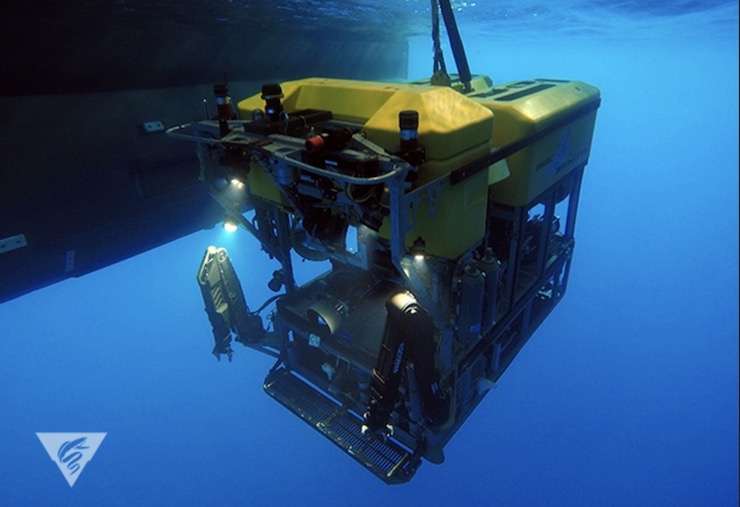
© mbari.org
Nestled between the northern coast of California and the Pacific Ocean lies Monterey Bay, a highly biologically diverse aquatic region. The bay has become famous for whale, dolphin, seal, otter, and marine bird watching. Below the water’s surface are countless species of fish and other marine creatures and plants, including a kelp forest. In the center of Monterey Bay, stemming from the coast of Moss Landing is Monterey Canyon. Though currents are constantly changing the landscape, at 249 miles long Monterey Canyon is one of the largest underwater canyons in the world. All of these conditions have made Monterey Bay an ideal oceanic research location. In 1987 American electrical engineer David Packard, co-founder of Hewlett-Packard, founded the Monterey Bay Aquarium Research Institute (MBARI) in Moss Landing.
The purpose of MBARI as outlined on their website is to “Develop innovative technologies for studying and understanding the ocean. Using that technology to explore and understand natural ocean systems. Share the knowledge gained, solutions devised, and the technology developed.” The non-profit institute of about 220 employees is now partially funded by the David and Lucile Packard Foundation. And as Mr. Packard said for his goal of those working at MBARI, “Take risks. Ask big questions. Don’t be afraid to make mistakes; if you don’t make mistakes, you’re not reaching far enough.” Through the development of underwater drones and other research tools, MBARI has certainly reached far.
In 1988, with engineering specifications made by Mr. Packard, MBARI received its first underwater drone. Vantana is a Remote Operated Vehicle (ROV) that originally came equipped with a simple system of cameras and data sensors. Since then, Vantana has been upgraded to state of the art data and sample collection instruments, moveable arms, HD cameras, and even a means of collecting living creatures. Vantana has made over 3,600 dives for MBARI. In 2009 MBARI developed a second ROV to conduct research called Doc Ricketts, named in honor of the marine ecologist Ed Ricketts. Both ROVs are tethered to a ship on the surface while in use. Operators carefully monitor everything the drones do while ensuring the tether remains undamaged. MBARI also developed an entirely electrical smaller drone called MiniROV to explore shallow waters.
In an effort to continue research while minimizing costs, MBARI began developing Autonomous Underwater Vehicles (AUVs) as well. As explained on MBARI’s website, “These platforms are low cost as compared to ships but can nevertheless be directed as to where, when, and what they sample to full ocean depth. Knowing that there would be demand for diverse payloads, MBARI engineers created a modular vehicle that can be quickly reconfigured to host a number of payloads without modifying basic components such as the propulsion, navigation, power, control, and emergency location systems.” MBARI has two types of these autonomous underwater drones, the Dorado-class AUVs and the Tethys AUV. Both are torpedo shaped drones that are programmed above the water surface, then sent to maneuver on their own. The website goes on to explain, “MBARI AUVs can measure physical characteristics of the water, such as temperature, salinity, and dissolved oxygen, detect chlorophyll from microscopic marine algae, and measure concentrations of small particles in the water, map the seafloor and collect images of the seafloor and the midwater.” The difference between the two models is that the Tethys AUV is designed to operate as a long-range drone.
Besides MBARI’s underwater drones they also utilize an Autonomous Surface Vehicle (ASV) called the Wave Glider developed by Liquid Robotics. Outfitted with specified MBARI gear, “The Wave Glider has a surfboard-like float at the surface and a sub with spring loaded paddles that uses wave energy for motion. It has solar panels on the float for supplying power to the linux-based computers, science instruments and communications gear. It has GPS for precise location measurement and weather station along with a collection of antennas for communications,” as stated on MBARI’s website. The Wave Glider is being used in place of costly scientific sea vessels that collect atmospheric ocean data. MBARI uses this drone typically for 2-10 week long missions. While the drone glides along, it is able to avoid collision with any obstacles and maintain communication with researchers on land.
MBARI has become one of the leading oceanic research centers in the world. In MBARI’s First Decade: A Retrospective, an article they released highlighting the organization’s early years, it says, “Packard realized that Monterey Bay—with its steep drop-off to near-abyssal depths within 100 kilometers (60 miles) of shore—offered an unprecedented opportunity to explore, in microcosm, the planet’s oceans. And, he realized that development of improved technology for observation of the deep ocean would offer great opportunity for scientific advances.” MBARI has been recognized as pioneers in how technology, especially drones, can advance aquatic research. Their cadre of drones have led to the discovery of many new animal and plant species, and a better understanding of how the ocean is ever-changing and affecting the world.
|